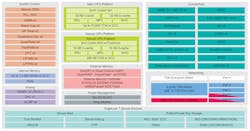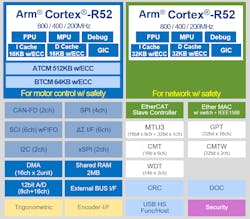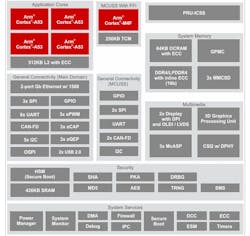Chip Giants Gear Up for Digital Factories of the Future
Chip makers are fortifying their wares for the industrial Internet of Things (IIoT) era, rolling out high-end embedded processors and microcontrollers (MCUs) with the rigor required to run the factory floors of the future.
NXP Semiconductors, Renesas Electronics, Texas Instruments, and other firms are getting more serious about the segment, upgrading their offerings to run the embedded systems safely and securely in a factory.
The modern factory is packed with sprawling networks of computing infrastructure and sensors to control and inform industrial robots and other automated systems. Companies are looking to improve operations using software and other tools such as predictive maintenance to fix heavy machinery before it wears out.
To stay ahead, semiconductor firms are innovating industrial-grade chips with more computing power than ever and reinforcing them with larger pools of local RAM memory to handle heavy-duty workloads.
They are also integrating more networking capabilities into chips, including time-sensitive-networking (TSN) standards and real-time industrial protocols to transfer around the factory faster and more reliably.
In addition, embedded hardware security modules (HSM) are often added to secure the hardware itself against hackers and safety-focused subsystems in chips packed in compact, rugged high-pin-count packages.
Ultimately, they are trying to give engineers more choices to help select the right component for their systems.
Sprawling Networks
The modern factory is becoming more automated, creating a complex web of industrial-grade networking protocols and fieldbuses. Many have dominated the factory for decades; others have to prove themselves.
NXP rolled out a line of high-performance MCUs with up to five Gigabit Ethernet ports that run a wide range of industrial networking protocols, including TSN. The i.MX RT1180 also supports real-time legacy protocols such as EtherCAT, PROFINET, EtherNet/IP, and CC-Link to help save space on circuit boards and reduce cost.
TSN is a relatively new set of networking standards that bring deterministic real-time communications to factories. It gives a shared understanding of time to sensors and other devices so that they can send time-critical data via Ethernet. TSN is rapidly becoming a major standard as information (IT) and operational technology (OT) can both run on the same network.
Tolerating temperatures of −40 to 125°C, the chip is based on a Cortex-M7 CPU clocked at 800 MHz paired with a 240-MHz Cortex-M33. The chip's memory subsystem centers on a large 1.5-MB block of RAM. This is supplemented by 512 kB of ECC-equipped cache for the Cortex-M7 CPU and 256 kB for the Cortex-M33.
It is also the first i.MX RT crossover MCU to integrate its NXP’s EdgeLock secure enclave. NXP said the preconfigured, self-managed, and autonomous on-die subsystem eases the challenges of industrial IoT security.
According to NXP, the secure enclave addresses the need for a root of trust with secure boot, authenticated debug, secure management of the device’s lifecycle, advanced key management, and tamper monitoring.
“Industrial and automotive customers are looking to provide increasingly advanced network capabilities and need a solution that not only provides processing power but can also manage time-sensitive network traffic,” said Jeff Steinheider, vice president and general manager of industrial edge processing at NXP.
The i.MX RT1180 is housed in compact BGA packages starting at 10 × 10 mm, making it easier to integrate TSN and real-time industrial networking into I/O management, motor control, or even industrial gateways.
Functionally Safe
As software takes over more of the modern factory, the systems inside are being held to higher standards for functional safety.
Renesas is aiming to address this with its new microprocessor called RZ/T2M, which runs real-time motor control for industrial servos and high-speed motors at the heart of robotic arms and other factory systems. TSN and other types of industrial Ethernet and functional safety are all integrated on a single chip.
Functional safety is all about reducing the risks of industrial equipment so that it can respond safely in the event of a malfunction. That is vital on a factory floor where industrial robots are operating in proximity to human operators. They must respond very fast to avoid potentially dangerous collisions when humans get too close.
At the heart of the RZ/T2M is a dual-core Cortex-R52 CPU clocked at up to 800 MHz, with one core designed for motor control and the other for networking. The peripheral functions used for motor control are linked directly to the CPU over a dedicated bus, allowing the CPU cores to access these functions with less latency.
The RZ/T2M adds 576 kB of on-chip memory tightly coupled (TCM) to the CPU. This reduces fluctuations in execution time that can occur when the cache is used, resulting in faster, more deterministic processing.
In addition to networking protocols such as EtherCAT, PROFINET RT, and EtherNet/IP, Renesas said it added support for PROFINET IRT and the latest TSN standard for communicating under tighter time constraints.
“The RZ/T2M is capable of controlling the servo motors that drive robots at extremely high speed and with high precision,” said Toshihide Tsuboi, VP of the industrial automation business at Renesas.
Designing robots or other heavy machinery that is functionally safe usually requires a pair of separate MCUs for safety monitoring. Renesas said the RZ/T2M is safe at its core: It can handle safety-critical processing in parallel with motor control and communications so only a single external MCU is required, reducing costs. The RZ/T2M, which has an operating temperature range of −40 to 125°C, contains 2 MB of shared RAM.
Renesas plans to roll out safety solutions, including a SIL 3-certified software kit that features a self-test kit for failure self-diagnosis, and a SIL 3 system software kit for mutual diagnosis and software isolation.
A suite of development tools called the Flexible Software Package (FSP) is available for the RZ/T2M.
Easy-Access Edge AI
A family of embedded processors from TI can help upgrade human-machine interfaces (HMIs) and IoT devices with edge AI.
The company said it rolled out the Sitara AM62x family, including the AM623 and AM625 with 3D GPU, to bring new ways of interacting with everything from the heavy machinery in factories to medical equipment. Instead of pressing buttons on a panel or tapping a display, TI revealed that it sees a future where you use hand gestures to give commands in a factory or remotely access machinery with a smartphone to diagnose faults.
With its power-efficient architecture and prices starting at less than $5, the AM62x helps lower the bar for engineers to add vision processing, predictive maintenance, and other AI-powered features to virtually any edge device.
The AM62x processors have up to four Arm-based Cortex-A53 CPUs clocked at up to 1.4 GHz, each core complemented by 32 kB of L1 cache and 512 kB of shared L2 cache with ECC. The chips are based on a 16-nm node, one of the most advanced technology nodes used in embedded and edge devices. They integrate 816 kB of on-chip SRAM. But memory expansion is possible with up to 4 GB of LPDDR4 and 8 GB of DDR4.
The AM62x family also features a dedicated display subsystem that supports dual displays of up to 1920 × 1080 at 60 fps.
A dual-core, 400-MHz Cortex-M4 CPU act as a hardware security subsystem with 426 kB of local RAM for key and security management. Cryptographic acceleration for up to 256-bit AES, up to 512-bit SHA2, and a public key accelerator (PKA) is also supported. The chips also feature secure boot with a hardware-enforced root of trust.
In addition, the chips contain a 400-MHz, real-time Cortex-M4 co-processor with up to 256 kB of TCM and a set of peripherals. TI said the subsystem can be isolated from the remaining hardware for safety purposes.
For functional safety, it has system capability up to SIL 3 and hardware integrity up to SIL 2.
On the networking front, the AM62x adds 2x Gigabit Ethernet ports, supporting the latest TSN standards. The chips are also packed with a wide range of general-purpose peripherals, including 3x SPI, 5x I2C, 8x UART, and 2x USB 2.0, as well as wired and wireless connectivity interfaces.
TI said the family adds all of this functionality without sacrificing power efficiency, slashing power up to 50% compared to the competition. As a result, systems powered by AA batteries can remain on for over 1,000 hours, according to the company.
The AM62x family features a simplified power-management architecture, with a pair of dedicated power rails and several power modes. Deep-sleep mode consumes less than 5 mW, allowing for longer battery life, while in the active-power mode, the processors can run on less than 1.5 W, leaving less heat to dissipate from the device. Without the need for bulky heatsinks, the AM62x can fit into space-constrained devices.
The AM623 and AM625 can run several operating systems at the same time, including Linux and Android.
The AM62x chips, rated for industrial temperatures of −40 to 105°C, are housed in industrial-grade 13- × 13- × 0.5-mm, 425-pin FCCSP BGA and 17.2- × 17.2- × 0.8-mm, 440-pin FCBGA packages.
About the Author
James Morra
Senior Editor
James Morra is the senior editor for Electronic Design, covering the semiconductor industry and new technology trends, with a focus on power electronics and power management. He also reports on the business behind electrical engineering, including the electronics supply chain. He joined Electronic Design in 2015 and is based in Chicago, Illinois.




